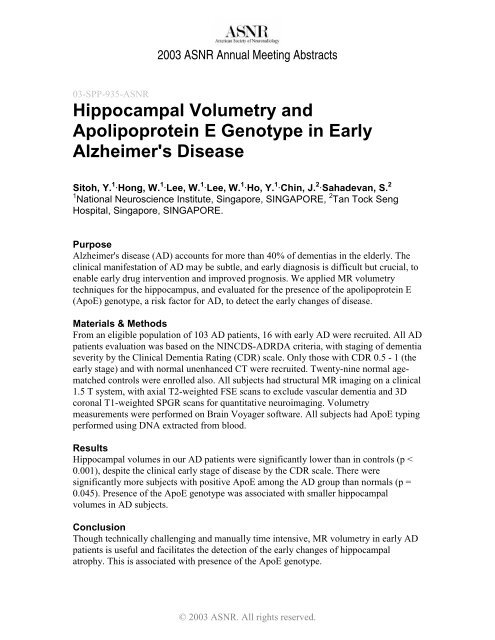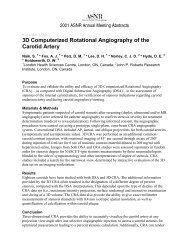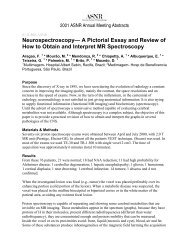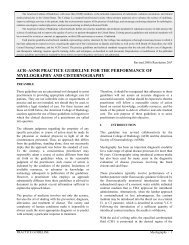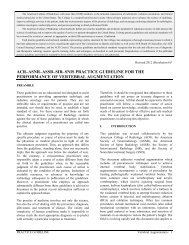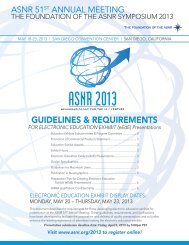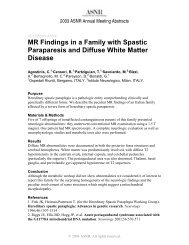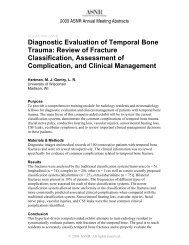Hippocampal Volumetry and Apolipoprotein E ... - For Members
Hippocampal Volumetry and Apolipoprotein E ... - For Members
Hippocampal Volumetry and Apolipoprotein E ... - For Members
You also want an ePaper? Increase the reach of your titles
YUMPU automatically turns print PDFs into web optimized ePapers that Google loves.
2003 ASNR Annual Meeting Abstracts<br />
03-SPP-935-ASNR<br />
<strong>Hippocampal</strong> <strong>Volumetry</strong> <strong>and</strong><br />
<strong>Apolipoprotein</strong> E Genotype in Early<br />
Alzheimer's Disease<br />
Author(s):<br />
Sitoh, Y. 1·Hong, W. 1·Lee, W. 1·Lee, W. 1·Ho, Y. 1·Chin, J. 2·Sahadevan, S. 2<br />
1 National Neuroscience Institute, Singapore, SINGAPORE, 2 Tan Tock Seng<br />
Hospital, Singapore, SINGAPORE.<br />
Purpose<br />
Alzheimer's disease (AD) accounts for more than 40% of dementias in the elderly. The<br />
clinical manifestation of AD may be subtle, <strong>and</strong> early diagnosis is difficult but crucial, to<br />
enable early drug intervention <strong>and</strong> improved prognosis. We applied MR volumetry<br />
techniques for the hippocampus, <strong>and</strong> evaluated for the presence of the apolipoprotein E<br />
(ApoE) genotype, a risk factor for AD, to detect the early changes of disease.<br />
Materials & Methods<br />
From an eligible population of 103 AD patients, 16 with early AD were recruited. All AD<br />
patients evaluation was based on the NINCDS-ADRDA criteria, with staging of dementia<br />
severity by the Clinical Dementia Rating (CDR) scale. Only those with CDR 0.5 - 1 (the<br />
early stage) <strong>and</strong> with normal unenhanced CT were recruited. Twenty-nine normal agematched<br />
controls were enrolled also. All subjects had structural MR imaging on a clinical<br />
1.5 T system, with axial T2-weighted FSE scans to exclude vascular dementia <strong>and</strong> 3D<br />
coronal T1-weighted SPGR scans for quantitative neuroimaging. <strong>Volumetry</strong><br />
measurements were performed on Brain Voyager software. All subjects had ApoE typing<br />
performed using DNA extracted from blood.<br />
Results<br />
<strong>Hippocampal</strong> volumes in our AD patients were significantly lower than in controls (p <<br />
0.001), despite the clinical early stage of disease by the CDR scale. There were<br />
significantly more subjects with positive ApoE among the AD group than normals (p =<br />
0.045). Presence of the ApoE genotype was associated with smaller hippocampal<br />
volumes in AD subjects.<br />
Conclusion<br />
Though technically challenging <strong>and</strong> manually time intensive, MR volumetry in early AD<br />
patients is useful <strong>and</strong> facilitates the detection of the early changes of hippocampal<br />
atrophy. This is associated with presence of the ApoE genotype.<br />
© 2003 ASNR. All rights reserved.
2003 ASNR Annual Meeting Abstracts<br />
References<br />
1. Shonk TK, Moats RA, Giffored P, et al. Probable Alzheimer's disease: Diagnosis<br />
with proton MR spectroscopy. Radiology 1995;195:65-72<br />
2. Arus C, Yen-Chang, Barany M, et al. Proton nuclear magnetic resonance spectra of<br />
excised rat brain. Assignment of resonances. Physiol Chem Phys Med NMR<br />
1985;17:23<br />
3. de Leon, et al. The hippocampus in aging <strong>and</strong> Alzheimer's disease. Neuroimag Clin<br />
North Am 1995;5(1):1-19<br />
4. Hyman BT, Van Hoesen GW, Damasio AR, et al. Alzheimer's disease: Cell-specific<br />
pathology isolates the hippocampal formation. Science 1984;225:1168-1170<br />
© 2003 ASNR. All rights reserved.


